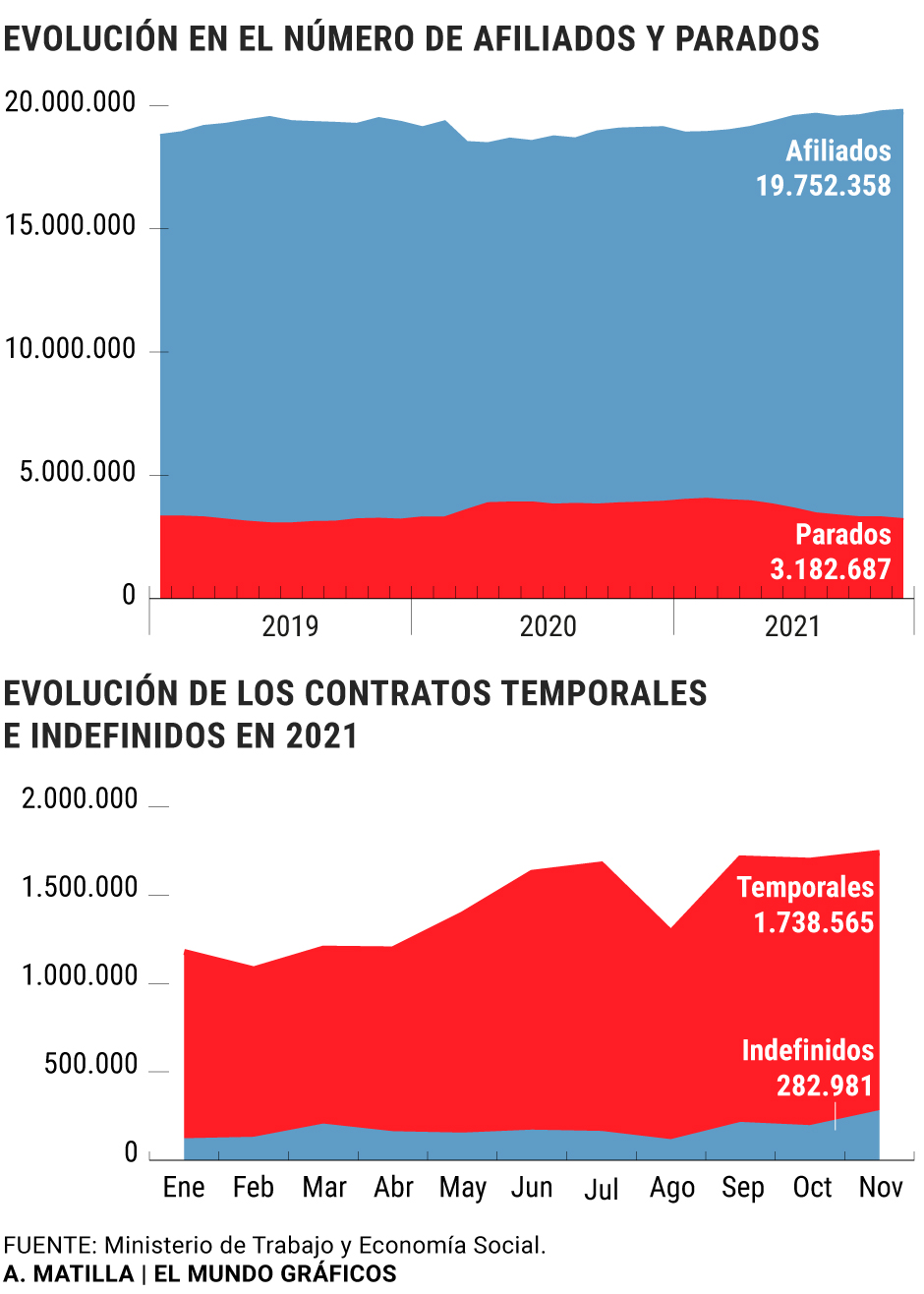The
unemployment
has fallen in Spain in November for the
ninth consecutive month and the number of workers discharged from Social Security has grown, but remains in the country
231,812 workers
with no activity and charging a
public benefit,
according to data released Thursday by the ministries of Labor and Social Security.
This is the case of the
125,000 wage earners
who as of December 1 are still affected by a Temporary Employment Regulation File (
ERTE
), of suspension or reduction, and of the
106,180 self-employed
who have their business closed or half full and are receiving a
benefit for cessation of activity.
Both groups are counted in the
19.75 million members
of Social Security, since although they are without work they are still registered, hence the
effective employment
is around
19.5 million people.
This total number of workers includes both the
private sector
and the
public sector.
For the latter, there is only data at the end of October, when there were around
2.77 million employees
between civil servants and labor personnel of the Administration, so it is expected that they will be even more at the end of November.
Employment recovers
Bearing this in mind,
Raymond Torres
, director of conjuncture and international analysis of
Funcas
, explains to EL MUNDO that the
effective employment of the private sector
(not counting workers in ERTE and self-employed workers in cessation of activity) has
not yet recovered the level prior to the crisis,
but it is foreseeable that it will do so in December. Today there would be around
20,000 or 30,000 fewer workers
in Spain
than in February 2020.
To make this estimate, they take into account the evolution of the public sector in October and also that the sectors that have pulled employment in November are precisely those in which it tends to predominate, such as
education
(which has been responsible for half of the jobs in jobs created in November, 29,735) or
administrative activities and auxiliary services
(+16,835) and
Public Administration and Defense and Compulsory Social Security
(+9,597).
On the opposite side are sectors such as the
hospitality industry
(which has destroyed 62,633 jobs) and
health activities and social services
(which has 8,973 fewer workers than in October).
In global terms, however, taking into account
all the workers
registered with Social Security, employment has recovered the pre-pandemic level.
"The recovery of employment to levels prior to the health crisis is good news and, especially, its positive impact on
women, young people and those sectors that had suffered the most
from the pandemic and that are still facing the uncertainty of the evolution of the sanitary situation and possible limitations in the normal development of the activity ", has underlined the CEOE after knowing the data.
In the opinion of the employers, the fact that the labor market is out of step with growth prospects, which are constantly being revised downwards, shows that the
current labor framework
is adequate for labor relations and
"favorable to job creation ".
More workers but fewer hours worked
However, although the total number of Social Security affiliates has grown and is approaching the record of 20 million workers who wanted to get before the pandemic broke, it would be useful to know
how many of these employees work full time,
since The latest Labor Force Survey (EPA) revealed that the
number of hours actually worked
continues to be
6.3% lower at the end
of the third quarter
than before the COVID.
This means that there are
more workers
but the
total number of hours worked is lower
, which leads directly to thinking about temporary or part-time contracts, which are the subject of debate these days in the negotiation of the labor reform.
So far this year (January-November),
temporary contracts have increased by 19.8%
year-on-year to 15.76 million registered, compared to 13.15 that were signed in the same period of the previous year.
The
permanent contracts
are much less, 1.94 million at the end of November, but they have grown more than the temporary ones, since
35.2% more
have been signed
than in the first eleven months of 2020.
Within the temporary ones, the number of those who are
part-time
has increased by 28.3% year-on-year
, to 5.35 million;
while
full-time
temporary contracts
amount to 10.3 million so far this year, 15.2% more.
According to the criteria of The Trust Project
Know more
Spain
Coronavirus
Unemployment
ERTE
job
economy
Economy The red lines between Díaz and Calviño: agreements, 15% of the temporality, do the unions win or not? ...
Labor Ultraactivity, petrification, sectoral agreements ... The dictionary to follow the negotiation of the labor reform
CommerceSpain has lost 7,000 exporting companies due to the pandemic
See links of interest
Last News
2022 business calendar
Home THE WORLD today
Holidays 2021
Podcast Economia
How to do
Spain - Argentina, live
Real Madrid - Athletic de Bilbao, live
Zalgiris Kaunas - Bitci Baskonia
Real Madrid - Maccabi Fox Tel Aviv

